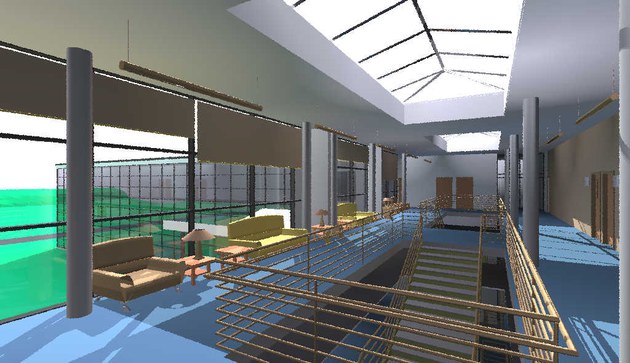RRadout
From schorsch, 24 Feb 2016:
I have recently had access to a Revit installation and decided to experiment a bit with its API. The resulting Python file is attached for anyone to try. I consider this a proof of concept implementation at the moment. There are many rough edges, and lots of features missing that would be expected in a full blown translator. It has been tested on the sample files supplied with Revit, but not on any other files.
I may or may not have access to Revit in the coming months, so this is what you get for now...
Technical considerations
Revit doesn't have the same geometry primitives as Radiance, but uses B-Rep geometry in winged edge representation. Surface elements don't close in on themselfes. This eliminates ambiguous positioning issues for the software. For an exporter, it means that eg. a cylinder is not one surface, but typically composed of two half-cylinders. A circle consists of two half arcs, etc.
Recognizing simple volume types requires analyzing and reassemblingseveral surface elements. This only seems to make sense forcircles/rings and cylinders (cones?) which are sufficiently easy.
Working features:
- Exports all geometry visible in the active 3D view (minus RPCs)
- Seperate function for exporting topography meshes.
- cylinders and circles/rings as Radiance primitives.
- Planar faces as polygons (including holes)
- All other surfaces tesselated into triangles (rectangles for partial cylinders.
- Names based on level and leaf node family name (type name for non-family types) and material
- Metric or imperial export (configured in code)
To do
- Turn into an external add-in
- Export RPCs in some way
- Export regions (parts of a surface using different color/material)
- Alternative primitive naming options (substitution lists?)
- Possibly split up the output into several files (eg. by level?)
- Detect cones (are those always coaxial in Revit?)
- Export unmodified (other than positioning/scaling) Family instances as seperate objects to be included via replmarks.
- Export (sufficiently large) meshes as Radiance meshes
- Export normals with curved surfaces for smoothing
- Export material properties in addition to the names
- Export light sources
- Export views
- Maybe export elements via selection instead of a complete view
- Dialog box to configure output interactively
- others?
Issues to research
- It's not always easily possible to figure out on which level a certain element resides (assuming they are associated with a level at all).
- Small objects with fine detail may result in many zero-area polygons.
- Installing an export function as a macro is clumsy. There may be a way to create an external installable via the Revit Python Shell.
Installation
Due to my lazyness, I created the exporter as an "Application Macro". Not sure if it can be installed as an external add-on without changes to the code. To install as a macro, select the "Manage" tab, click on "Macros". Select the "Application" tab in the opening dialog, and press "Create Module". Give your new application a name, chose "Python" as a language and press "Ok". The SharpDevelop IDE should open with a new project containing boilerplate code. Replace that with the contents of my file and press F8 to compile.
Now open the "Macros" dialog again, and your Module will have sprouted two macros named "ExportToRadiance" and "ExportTopoToRadiance". Select one of those and press "Run" (only works if the current view is a 3D-view).
Configuration
Currently all relevant configuration happens in the code, near the top of the file. Configuration options are:
- Metric or Imperial
- Output file name (default: "revout.rad" on your desktop)
- Output file name for topography (default: "revout_topo.rad" on your desktop)
The attached jpg is from one of the Revit samples. The scene file is around 50MB. Ironically, just in this example, the Brown chair at left shows some missing faces at the front of the armrest... Not sure if this is my fault or Revit's.
Anyone who wants to try improving and extending RRadout, just go ahead and share your results. Depending on the feedback, I may create a Github project.
Have fun!
-schorsch
Download RRadout_01.py.zip
Download RRadout_01.py.tgz

